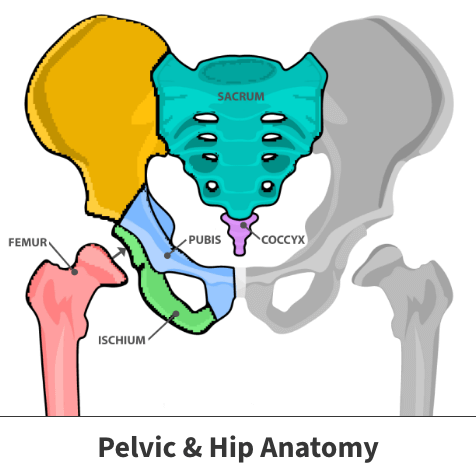Hip arthroscopy
Hip arthroscopy is a surgical procedure that involves inserting a small camera into the hip joint to look for damage and determine the best way to treat the present injury. This procedure involves a small cut (incision), about the size of a buttonhole, rather than larger incisions used in traditional operations. All the other details involved with this surgery such as recovery time, procedure length, etc. are dependent on how severe your hip injury is and the difficulty of fixing it. The majority of all people who have a hip arthroscopy can return to full, unrestricted activities after the procedure.
Anatomy

The hip is a ball and socket joint. The socket is formed by the large pelvis bone (acetabulum), and the ball is the upper end of the thighbone (femoral head). A slippery tissue known as the articular cartilage covers the surface of the joint, creating a smooth surface that allows for the bones to easily glide across each other.
The large pelvis bone is ringed by strong fibrocartilage known as the labrum which forms a lining around the socket.
Additionally, the whole joint is surrounded by bands of tissue (ligaments) that form a capsule that acts to hold the joint together. The undersurface of the capsule is lined by a thin membrane (synovium) which produces synovial fluid that lubricates the hip joint.
About
Hip arthroscopy is a surgical procedure that uses a small camera (arthroscope) to view the hip joint without making a large cut (incision) through the skin and other soft tissues. Since the arthroscope is small and requires only a small incision, your recovery is easier and significantly less painful than someone with the typical, larger incision.
This procedure is generally recommended to people who are in severe pain that did not go away with nonsurgical treatments, such as medications and physical therapy.
Before the procedure, your Florida Orthopaedic Institute physician will check over your symptoms, medical history, and overall health to determine if this procedure is right for you.
The surgery can be performed as an outpatient, meaning you will not have to stay at the hospital overnight. You will be given specific instructions ahead of time on the specifics of the procedure. Make sure to follow the instructions on when to arrive and especially on when to stop eating or drinking before your procedure.
Once the muscle is injured, it becomes vulnerable to re-injury.
Symptoms
A hip muscle strain causes pain and tenderness in the injured area. Other symptoms may include an increased pain while using the injured muscle, swelling, limited range of motion, and muscle weakness.
Diagnosis
If you experience any of the symptoms listed above, then you may have strained your hip muscle. Before seeking an official diagnosis, it is beneficial to do the nonsurgical treatments listed below. If pain persists, your Florida Orthopaedic Institute physician will conduct a physical examination, as well as X-rays to determine what part of the hip is injured, if there are any other injuries and if surgery will be necessary.
Treatment
Hip arthroscopy is usually performed under general anesthesia, which is when you are put to sleep for the procedure. Before the surgery, you will be evaluated by an anesthesiologist to determine the correct amount of anesthesia needed.
Right before the procedure, lines are typically drawn on the leg to help show specific anatomy structures like bones, nerves, and blood vessels. Lines are also drawn to show the incision placements and portals for the arthroscope.
At the start of the procedure, your leg will be pulled away from the socket enough for your surgeon to insert instruments, see the entire joint, and perform whatever treatments are needed. This is called traction.
Once traction is applied, a small puncture roughly the size of a buttonhole is made for the arthroscope. Fluid flows through the arthroscope to keep the view clear and control any bleeding.
After your surgeon takes a good look at your joint and confirms the problem, they insert other small instruments through a separate incision to repair it. There are several procedures that can be done depending on the specific situation. Some examples include:
- Trim bone spurs caused by FAI (Femoroacetabular Impingement)
- Smooth off or repair torn cartilage
- Remove inflamed synovial tissue
The length of the procedure depends on your own specific injury.
Recovery
After surgery, you will most likely be prescribed medications for short-term pain relief.
You may also be prescribed a combination of these medications to decrease pain and minimize the need for opioids. Although opioids can help relieve pain after surgery, they are a narcotic and can become addictive.
Besides medications that relieve pain, you may also be given ones that lessen the risk of blood clots, such as aspirin.
Crutches may be necessary after your procedure to keep weight off of your hip until it has recovered enough for you to move around safely.
Many people return to full, unrestricted activities after hip arthroscopy. Your recovery will depend on the type of damage that was present in your hip.
Videos
Related specialties
- Anterior Hip Replacement
- Avascular Necrosis (Osteonecrosis)
- Groin Strains & Pulls
- Hamstring Injuries
- Hip Arthroplasty
- Hip Dislocation
- Hip Flexor Strains
- Hip Fractures
- Hip Hemiarthroplasty
- Hip Impingement Labral Tears
- Hip Muscle Strains
- Hip Pointers & Trochanteric Bursitis
- Iliopsoas Tenotomy
- Labral Tears of the Hip (Acetabular Labrum Tears)
- Osteoarthritis of the Hip
- Osteoporosis
- Pelvic Ring Fractures
- Piriformis Syndrome
- Sports Hernias (Athletic Pubalgia)
- Thigh Fractures
- Thigh Muscle Strains
